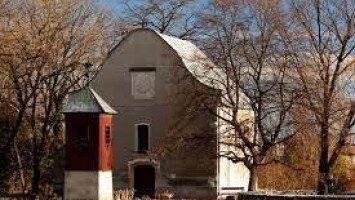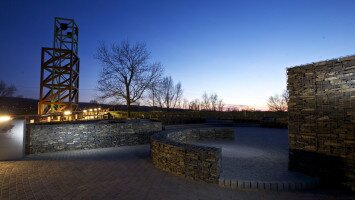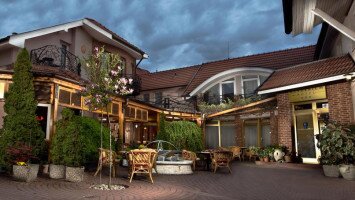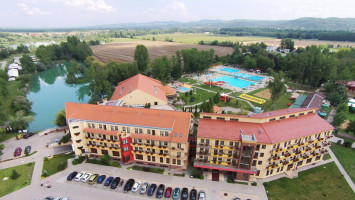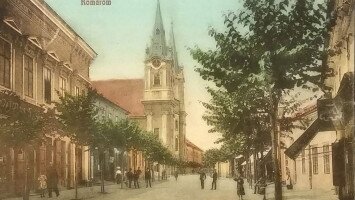
History of Nové Zámky
The history of Nové Zámky is often associated with the Middle Ages, when there were four medieval villages on the territory of today's Nové Zámky - Nyárhíd, Gúg, Györök, and Lék. Professional literature considers the construction of the first Nové Zámky fortress on the left bank of the Nitra river in 1545 to be the establishment of Nové Zámky.
The second, modern Renaissance fortress was built in marshy terrain on the right bank of the Nitra River in the years of 1573-1580. The new fortress was designed by Italian architects Ottavio and Giulio Baldigarovci. The fortress had a regular hexagonal floor plan with massive earring bastions for artillery. The walls were surrounded by a wide moat, which was connected to the Nitra River. The nobleman Fridrich Žerotín had military supervision over the construction of the fortress. Nové Zámky became the center of anti-Turkish defense in western Slovakia in the 16th and early 17th centuries. After its completion, Nové Zámky was considered one of the best fortresses of the Habsburg monarchy. The importance of the fortress is also evidenced by several Ottoman attacks, which the fortress survived for half a second century. During the Fifteen Years' War (1593-1608), Nové Zámky and its surroundings ravaged Crimean Tatars and the troops of Grand Vizier Ibrahim Pasha. In 1663, the Nové Zámky Fortress became the target of an Ottoman army expedition led by the Grand Vizier, Pasha Ahmed Köprülüm. The defense of Nové Zámky was weakened by the ill-considered action of the commander of the Nové Zámky fortress, Count Adam Forgách, who wanted to prevent the Ottoman army from crossing the Danube by destroying the pontoon bridge, but underestimated the strength of the Ottoman army and suffered a heavy defeat. This ill-considered action by Adam Forgách subsequently weakened the defense of the Nové Zámky fortress. Grand Vizier Ahmed Köprülü arrived at the walls of the Nové Zámky fortress in mid-August 1663 and within a few days, on August 18, he began conquering the fortress. The first weeks of conquering the fortress were not successful for the Ottomans. The Nové Zámky garrison successfully resisted the Ottoman attacks for several weeks. Fighting for the Nové Zámky fortress culminated in the second half of September 1663. After the explosion on the bastion of Friedrich's bastion, the garrison in Nové Zámky was forced to surrender, and on September 24, 1663, it hung a white flag.
Grand Vizier Ahmed Köprülü Pasha declared Nové Zámky the center of a new province - Eyalet-i Uyvar. Kurd Mehmed became the first viceroy of Nové Zámky. Shortly after his death, he became the new viceroy of Pasha Sara Hussein. The Ottomans sought to secure income from the payment of taxes and benefits in kind from their subjects. The city and its surroundings under Ottoman rule suffered greatly. It was not until July 7th, 1685 that Charles of Lorraine and Colonel Heisler began military actions against Nové Zámky. They surrounded the fortress, and when the Grand Vizier Pasha Ibrahim besieged Esztergom at the beginning of August 1685, Field Marshal Caprara remained below Nové Zámky. Caprara secured fords across the Nitra River so that the Ottoman crew would not receive assistance. Caprara focused on shelling the bastions and the inner fortress, while the grocery store and the Franciscan church burned down. Imperial troops penetrated to the walls and on August 19, 1685, occupied the fortress. The castle was liberated after 22 years of Ottoman rule. Unfortunately, most of the monuments after the Turks were destroyed. In 1691, Archbishop Juraj Szécsényi issued a privileged charter, which promoted Nové Zámky to a town. Nové Zámky also played an important role in the uprising of František Rákóczi II. The fate of General Ladislav Ocskaya, who betrayed the Kurucs, is also associated with Nové Zámky. Adam Jávorka, a lieutenant in the Nové Zámky castle disguised as a beggar, captured him. The military court convicted Ocskaya and executed him on the 3rd of January, 1710 in Nové Zámky. Today, the place of execution is marked on the paving of the Main Square with a memorial plaque. The castle was last repaired in 1705 under the supervision of Duke Bercsényi (its epitaph is still on the facade of the Franciscan monastery). At the order of Charles III. in 1724-1725, the Nové Zámky castle was demolished. This ended his 150-year strategic-historical role. To this day, most bastions have a distinctive form that allows their location to be identified.
Location of bastions
Cisárska bašta EW - Slovak Monuments Institute
Česká bašta NE - Synagogue
Ernestova bašta N - Zámčan, Sporiteľňa
Forgáchova bašta SE - Kalvária
Fridrichova bašta W - Vodáreň
Žerotínova bašta S - Building constructions
In the 18th century, instead of the castle's military role, economic development came to the fore, and the importance of trade and crafts also increased.In 1843 a document was issued, which was given the coat of arms of the city. In 1850, railway transport began to operate on the Vienna - Bratislava - Nové Zámky - Budín line. In 1871, there were four printers in the city. In 1892, a 102 m long reinforced concrete bridge over the Nitra River was built. Horse markets, which lasted two days, had a long tradition in the town.
On August 18, 1935, the inhabitants organized a spectacular celebration in honor of the 250th anniversary of the liberation of the city from Turkish rule and unveiled a monument, which is still a cultural monument and is located on G. Czuczora street in the park of the Gergely Czuczora Primary School with a Hungarian language of instruction. On this occasion, they also opened the first museum in Nové Zámky, which was destroyed by bombing in 1945. In 1937, a monument to Anton Bernolák, Dean of Nové Zámky, Slovak writer and linguist, the first codifier of the Slovak literary language, was unveiled. The statue is the work of the academic sculptor Jozef Pospíšil and is currently located on the Main Square. The Nové Zámky cemetery of St. Joseph was opened in 1926 and many important personalities are buried in it.Source: https://www.novezamky.sk/Photo: Péter Pogány, Wikipedia


